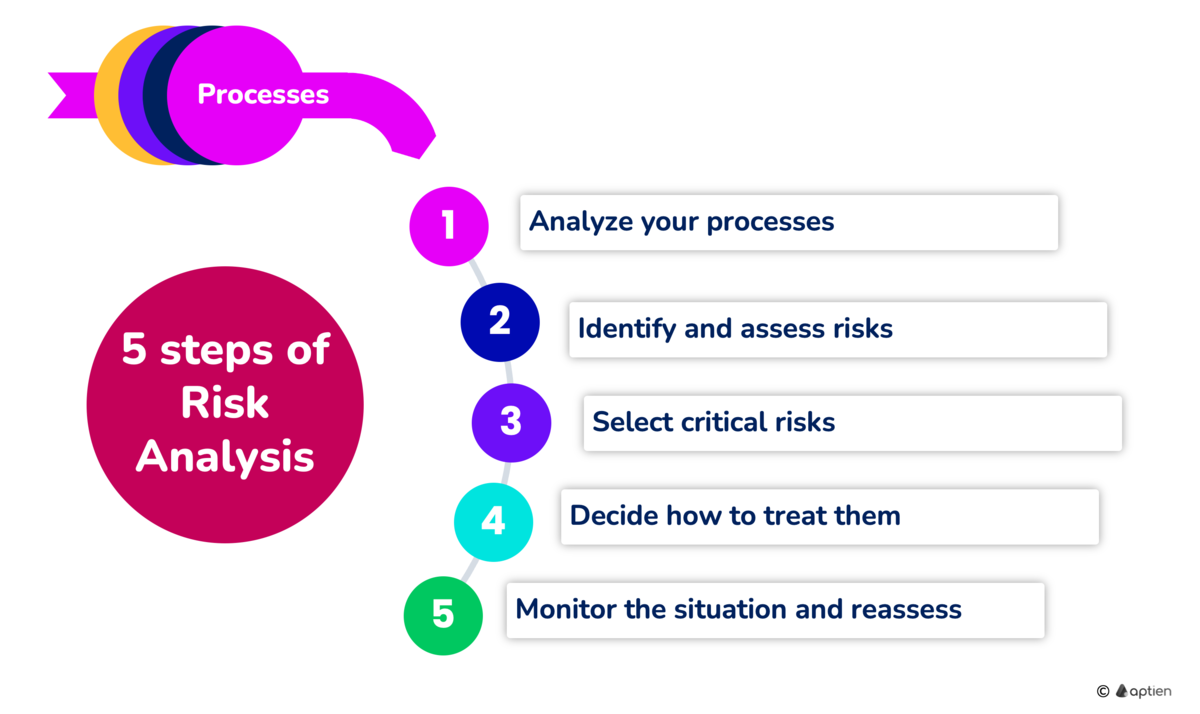Understand Your Processes to Identify Key Risks
Process-based Risk Assessment is one of the most common methods for identifying and analyzing risks. Knowing your key processes is essential: without this knowledge, your risk list won’t be accurate or complete. You need to understand your critical processes—those that, if they fail, get blocked, or stop completely, could seriously harm or even shut down your business.
In this article, we’ll walk you through the basic steps for conducting risk identification and assessment based on your processes. We’ve outlined 5 simple steps to help you identify, evaluate, and manage risks so you don’t get overwhelmed.
Why Analyze Risks Based on Processes?
- Processes are one of the main sources of risks
- A process-based approach makes it easier to identify mission-critical and operational risks
- For many business risks, this approach works better than an asset-based approach, which is better suited for spotting technical risks
- Asset analysis can’t uncover potential problems or errors within processes. Issues like poorly designed workflows or employees not following procedures often go unnoticed with asset analysis
- That said, process-based risk analysis complements the asset-based approach. Each method helps identify different types of risks
- It’s recommended to start with processes since they give a clearer view of what’s critical to keeping your business running
5 basic steps of risk analysis using processes
If you don’t have your processes mapped, there are many ways and techniques to do it
- You have basic processes and their descriptions in your policies
- You can also start from a process template or a process list, for example in the process library
Step 1: Make a List of Your Key Business Processes
Start by mapping how your business runs day-to-day. This helps you identify the most important activities and focus on the biggest risks, especially those tied to your mission-critical processes.
- List Your Processes
- Identify Critical Processes
Guidelines for Identifying Critical Processes:
- Prioritize Importance: Not all processes matter equally. Concentrate on the ones that keep your business operating.
- Core Processes First: Begin with processes that deliver value to your customers—these are usually the core functions of your business.
- Assess Impact: Flag processes that, if interrupted or stopped, would cause serious harm to operations, revenue, or reputation.
- Focus on Value Creation: Start with core areas like sales, invoicing/billing, production, and service delivery so you can address the key risks that affect everyday operations.
Step 2: Identify and Name the Risks That Could Impact Your Processes
Process and organizational risks usually come from missed steps, unclear procedures, or activities not being followed correctly.
- Any process can have risks due to human mistakes, intentional wrongdoing, equipment failure, or other reasons.
- Common examples include incorrectly entered invoices or unsafe practices when operating machinery.
- Each process may also have specific threats and vulnerabilities, so make sure to note them down.
- Carefully review each process to find and list potential risks.
- By the end of this step, you'll have a complete list of all identified risks from your process review.
Step 3: Conduct a Risk Assessment and Prioritization
It's important to prioritize your list of risks because you can't address everything at once. For each risk, assess how likely it is to happen and the potential impact it could have.
- Focus on the risks that pose the greatest threat to your business
- Determine this by estimating the likelihood and potential impact of each risk
- Risks with both high likelihood and high impact should be your top priority
- The risk matrix can help you clearly identify which risks need immediate attention and which are less urgent
- Use the risk register to document details about each risk
Step 4: Decide How to Treat and Manage the Risks
Based on your priorities, move on to the final step: developing a plan to address the risks. Focus on the most critical risks identified earlier and determine how you will handle them, including specific risk treatment strategies. Concentrate on the top 10 most important risks. Remember, most risks can't be completely eliminated, but you can work to reduce their likelihood or impact on your business operations.
- Focus on your priority risks
- Decide which risk treatment approach you'll use for each risk
- Develop measures and preventive actions for the selected risks
Step 5: Review and Update Your Processes and Risks Periodically
Things change, and you need to adapt. Some risks go away, the likelihood of others may change, and new risks can come up. It’s important to keep your processes current so you’re not wasting time addressing risks that no longer exist, and you don’t overlook new ones.
- New risks can emerge, while old ones may become less relevant or disappear
- Regular reassessment is key
- Doing this once a year works well for most businesses
